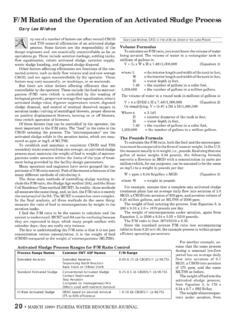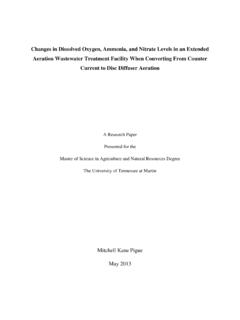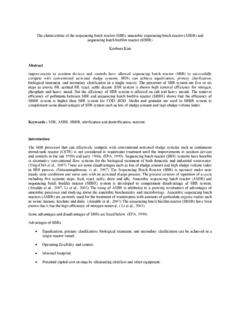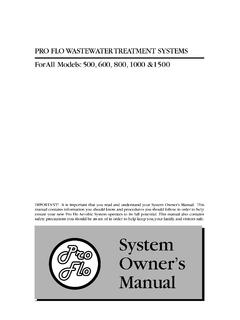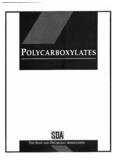Transcription of A Review on Oxygen Transfer Rate, Efficiency, Capacity and ...
1 International Journal of Scientific and Research Publications, Volume 4, Issue 12, December 2014 1 ISSN 2250-3153 A Review on Oxygen Transfer Rate, efficiency , Capacity and their Kinetic on Aeration System in Activated Sludge Process of Sewage Treatment Plant Poonam Barge1, Malviya2 and Nitesh Parmar3 final year student of Department of chemical engineering, IPS Academy Indore ( ) 2 Process incharge at 50 mLd. STP Plant, Jodhpur, Rajasthan 3 Assistant Professor at Department of chemical engineering, IPS Academy Indore ( ) Abstract- The Review is concerned with the Transfer of Oxygen from air to a wastewater subjected to biological aerobic treatment.
2 Oxygen Transfer from gaseous to the liquid phase, is a vital part of a number of wastewater treatment processes, such as activated sludge process which is totally depend on the availability of sufficient quantity of Oxygen . This paper is a study of Oxygen Transfer rate, efficiency , Capacity and their kinetics on aeration system. Apart from this the study shows how the sludge retention time and the Oxygen uptake rate is depend on the temperature of wastewater of sewage treatment plant. The standard Oxygen Transfer rate is the decisive factor in the dimensioning of activated sludge process used in STP Plants.
3 It depends on the required Oxygen uptake rate by micro-organisms. This Review discuss about the dependency of Oxygen Transfer rate on the temperature of wastewater. Index Terms- Aeration systems, activated sludge process, mass Transfer , Oxygen uptake rate (OUR), Oxygen Transfer rate, Oxygen Transfer efficiency , sludge retention time (SRT), wastewater temperature. I. INTRODUCTION eration systems normally perform two functions in activated sludge wastewater treatment processes, namely, Oxygen Transfer and mixing. While Oxygen Transfer may be regarded as the primary function, mixing is also important to ensure a full utilization of the activated sludge reactor volume and a uniform dispersion of dissolved Oxygen throughout the mixed liquor.
4 The Transfer rate of Oxygen from air to waste water subjected to biologically treatment. the rate of Oxygen Transfer essential for specification of aerator to be utilize this process Fine bubble aeration is known for a higher Oxygen Transfer efficiency than surface aeration, but equipment costs as well as maintenance costs for surface aerators are lower often. An economic evaluation of both systems often results in fine bubble aeration, but depending on individual conditions also surface aeration is chosen due to economic benefits. Therefore Oxygen Transfer measurements for surface aerators are still important.
5 Oxygen must be provided in biological wastewater treatment systems to satisfy several types of demands. One demand is that associated with the oxidation of organic or carbonaceous materials. Carbonaceous Oxygen demand is associated with two cellular functions: cell synthesis and endogenous respiration. Cell synthesis carbonaceous Oxygen demand occurs when organic matter is first metabolized by the microorganisms contained in the mixed liquor. It is related to the Oxygen required to oxidize a portion of the organic matter to provide the energy necessary for cell synthesis.
6 Endogenous respiration carbonaceous Oxygen demand occurs as the synthesized organisms are retained in the treatment system and it represents the essential life processes. The net result is that increasing amounts of Oxygen are required as lower process organic loadings are used. Lower process organic loadings are characterized by operation at a longer solids retention time (SRT) and lower food-to-microorganism (F/M) loadings. The efficiency of Oxygen Transfer depends on many factors including the type, size and shape of diffusers and the tank geometry. In this paper, the effect of the depth of water in the tank and, the extension of coverage area of diffusers on each of Oxygen Transfer Capacity (OC), efficiency (E) their size, shape, and materials of construction may vary considerably, diffused aeration devices are usually classified as either fine or coarse bubble referring to the relative diameter of the bubble produced.
7 The demarcation between fine and coarse bubbles is not well defined. The standard Oxygen e Transfer is the decisive factor in the dimensioning of activated sludge plants. It depends on the required Oxygen uptake rate by microorganism. The dependencies of the Oxygen Transfer rate and Oxygen uptake rate on the waste water temperature range (5 30 0 C) are discussed. II. MATERIAL AND METHOD The process of Oxygen Transfer to gaseous to aqueous phase occurs in few steps. In the first step saturation of liquid surface between two phases (Cs saturation of concentration of liquid) this Transfer rate will very fast which gaseous film is negligible.
8 Passage of the Oxygen molecules through the liquid interface film by molecular diffusion at very low mixing levels the rate of Oxygen absorption is controlled, at higher turbulence levels interface film is broken up and rate of renewal of the film control absorption of the Oxygen . Surface renewal rate is frequency at which the liquid with an Oxygen concentration CL ( Oxygen concentration in bulk of the liquid phase) replace that from the interface with on the Oxygen concentration equal to saturation concentration of liquid CS. Oxygen transferred to bulk liquid by diffusion and by convection.
9 A International Journal of Scientific and Research Publications, Volume 4, Issue 12, December 2014 2 ISSN 2250-3153 The basic equation of Oxygen Transfer rate is: N = KLA (Cs CL) .. (1) Where, N = Mass Oxygen transferred per unit time (lb O2 /day), KL= The liquid film coefficient (lb O2 /day ft2), A = Interfacial area in Transfer (ft2), Cs = Saturation of concentration of liquid (Mg/l), CL = Oxygen concentration in bulk of the liquid phase (Mg/l). Equation no.(1) is usually rewritten in concentration units by dividing by volume of the system.
10 N/V = dt/dCL = KL (A/V) (Cs CL ) = KLa (Cs - CL) .. (2) Where, a = A/V = interfacial area per volume (ft2/ft3) KLa = the overall coefficient of Oxygen Transfer (lb/O2 (day) (ft3)) In the determination of the mass Transfer coefficient, the overall coefficient KLa is obtained without attempting to separate the factor KL and a. It is admittedly impossible to measure the interfacial area A. MASS Transfer COEFFICIENT AT UNSTEADY STATE IN AERATION TANK FOR ACTIVATED SLUDGE PROCESS In aeration of activated sludge water, Oxygen utilization (respiration rate) at microorganism is taken into account, with reference equation no.











